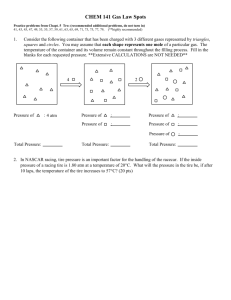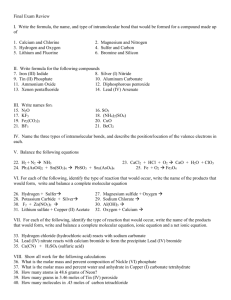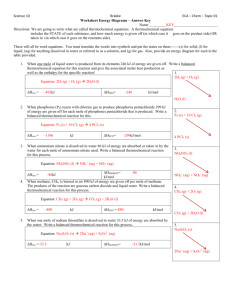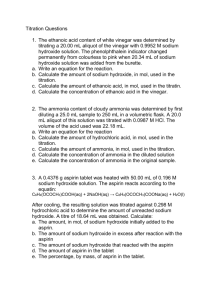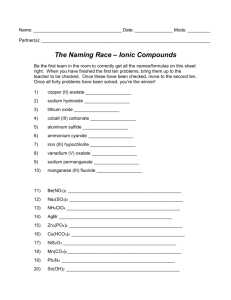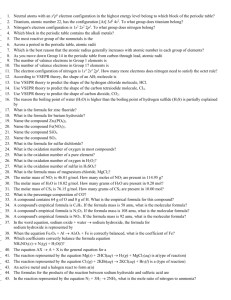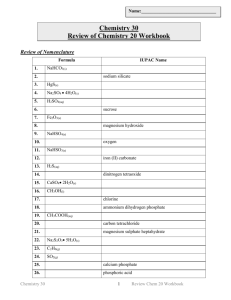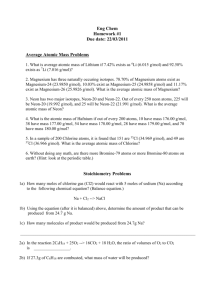THE MOLE 1. What is the molar mass of each of the following? a. Al
advertisement
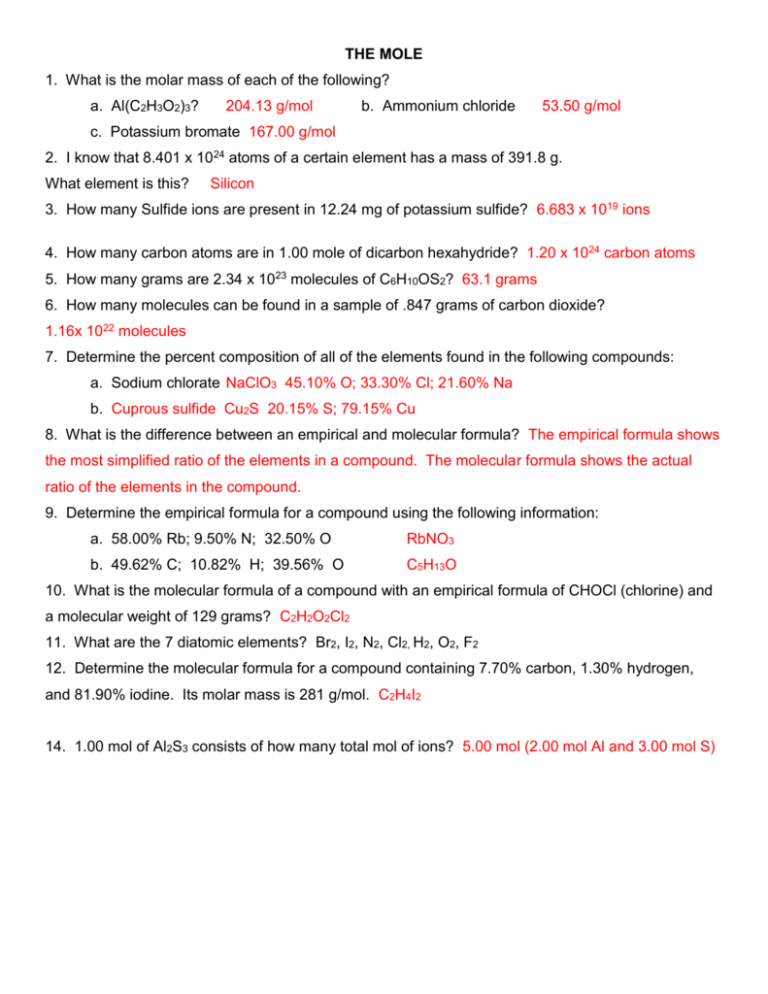
THE MOLE 1. What is the molar mass of each of the following? a. Al(C2H3O2)3? 204.13 g/mol b. Ammonium chloride 53.50 g/mol c. Potassium bromate 167.00 g/mol 2. I know that 8.401 x 1024 atoms of a certain element has a mass of 391.8 g. What element is this? Silicon 3. How many Sulfide ions are present in 12.24 mg of potassium sulfide? 6.683 x 1019 ions 4. How many carbon atoms are in 1.00 mole of dicarbon hexahydride? 1.20 x 1024 carbon atoms 5. How many grams are 2.34 x 1023 molecules of C6H10OS2? 63.1 grams 6. How many molecules can be found in a sample of .847 grams of carbon dioxide? 1.16x 1022 molecules 7. Determine the percent composition of all of the elements found in the following compounds: a. Sodium chlorate NaClO3 45.10% O; 33.30% Cl; 21.60% Na b. Cuprous sulfide Cu2S 20.15% S; 79.15% Cu 8. What is the difference between an empirical and molecular formula? The empirical formula shows the most simplified ratio of the elements in a compound. The molecular formula shows the actual ratio of the elements in the compound. 9. Determine the empirical formula for a compound using the following information: a. 58.00% Rb; 9.50% N; 32.50% O RbNO3 b. 49.62% C; 10.82% H; 39.56% O C5H13O 10. What is the molecular formula of a compound with an empirical formula of CHOCl (chlorine) and a molecular weight of 129 grams? C2H2O2Cl2 11. What are the 7 diatomic elements? Br2, I2, N2, Cl2, H2, O2, F2 12. Determine the molecular formula for a compound containing 7.70% carbon, 1.30% hydrogen, and 81.90% iodine. Its molar mass is 281 g/mol. C2H4I2 14. 1.00 mol of Al2S3 consists of how many total mol of ions? 5.00 mol (2.00 mol Al and 3.00 mol S) CHEMICAL REACTIONS 1. For each of the following: a. Indicate the type of the reaction b. Predict the products by name c. Write the equation for the complete reaction. If the reaction does not occur, write NR. d. For DD reactions include the states e. Balance the reaction only if it occurs a. silver nitrate + cupric chloride DD (precipitate) – silver chloride and cupric nitrate 2AgNO3(aq) + CuCl2(aq) 2AgCl(s) + Cu(NO3)2(aq) b. copper (II) + aluminum sulfate NO REACTION c. sodium nitrite + ammonium sulfate NO REACTION d. iodic acid D4 - diiodine pentoxide and water 2HIO3 I2O5 + H2O e. hydrochloric acid +barium hydroxide DD (neutralization)-water and barium chloride 2HCl(aq) + Ba(OH)2(aq) BaCl2(aq) + H2O(l) f. sodium + chromium (II) chlorate SD – sodium chlorate and chromium 2Na + Cr(ClO3)2 2 NaClO3 + Cr g. cupric oxide D2 – copper (II) and oxygen 2CuO 2Cu + O2 h. C4H8 + oxygen (complete) C – carbon dioxide and water C4H8 + 6O2 4CO2 + 4H2O i. dibromine pentoxide + water S4 – bromic acid Br2O5 + H2O 2HBrO3 j. iron (II) oxide + carbon dioxide S5 – iron (II) carbonate FeO + CO2 FeCO3 k. chlorous acid + magnesium hydroxide DD (neutralization) – water and magnesium chlorite 2HClO2(aq) + Mg(OH)2(s) Mg(ClO)2(aq) + 2H2O(l) l. aluminum carbonate D5 – aluminum oxide and carbon dioxide Al2(CO3)3 Al2O3 + 3CO2 m. Sodium sulfide + hydrochloric acid DD (gaseous) – sodium chloride and hydrogen sulfide gas Na2S + 2HCl(aq) 2NaCl (aq) + H2S(g) 3 n. hydrobromic acid + calcium carbonate DD (gaseous) -calcium bromide, carbon dioxide, and water (carbonic acid breaks down) HBr(aq) + CaCO3(s) CaBr2(aq) + CO2(g) + H2O(l) 2. What is the difference between oxidation and reduction? Oxidation is a loss of electrons by one reactant. Reduction is a gain of electrons by one reactant. 4. What are the four main signs that a chemical reaction has occurred? Evolution of a gas; temperature change; precipitate; color change STOICHIOMETRY 1. How many grams of potassium sulfate are produced if 10.0 g of sulfuric acid and 7000.0 mg of potassium hydroxide are mixed together? What is the limiting reactant? LR = KOH; 10.872 g 2. How many moles of chloric acid are required to react completely with 2.05 g of sodium carbonate? .0387 mol 3. The reusable booster rockets of the U.S. space shuttle employ a mixture of aluminum and ammonium perchlorate for fuel. The balanced equation is 3Al(s) + 3NH4ClO4 Al2O3(s) + 3NO(g) + 6H2O(l) NH3(g) What mass of ammonium perchlorate should be used in a fuel mixture for every 1.00 kg of aluminum used? 4.36 kg 4. How many grams of magnesium chloride are produced if 420 cm 3 of chlorine gas reacts with 14.8 g of Magnesium at STP? 1.8 g MgCl2 5. If the following reaction produces 6840 J of energy, how many grams of CrO 3 is used? 127 g CrO3 + H2O H2CrO4 + 5.4 kJ 6. How much heat is absorbed/released when 193 g of ammonium bromide react according to the following equation? NH3 + HBr NH4Br ΔH = 188.32 kJ 371 kJ released (enthalpy is reversed because reaction is reversed SOLUTIONS 1. If 960 g of sodium hydroxide are used to prepare 16000 mL solution. What is the molarity of the solution? 1.5 M 2. If we add .15 L of a 6.02M HCl solution and some water to a beaker, creating a 2.42 M HCl solution, what is the volume of the new solution? .37L 3. A 2.34 M solution contains 10. g of acetic acid. What is the volume of the solution in mL? 71 mL 4. What mass of sodium oxide is consumed if it reacts with 12.3 mL of a 3.45 M HCl solution? 1.32g 5. How many grams of .67 M KClO3 are needed to prepare 1.00 Liters of solution? 82 g 6. Describe how 100 ml of a .10 M solution of sodium hydroxide would be made. Fill a volumetric flask approximate 2/3 full of water. Add .4 grams of sodium hydroxide to the flask. Swirl the flask. Add remaining 1/3 of water to the solution until meniscus is at the line on the flask. Mix. 7. Using the pH scale, define an acid and a base. An acid is a substance with a pH value of 0 – 6.99 and a base is a substance with a pH value of 7.01 - 14 CHEMICAL BONDING 1. What is the difference between an ionic and a covalent bond? An ionic bond is a bond commonly formed between a metal and a nonmetal. A covalent bond is a bond commonly formed between two nonmetals. 2. Would the following pairs most likely form an ionic or molecular compound? a. Mg and Cl - ionic b. b. I and F - molecular c. P and Cl - molecular d. Sn and O - ionic e. Ag and S - ionic 3. Draw a Lewis dot diagram for each of the following: a. b. c. d. e.
